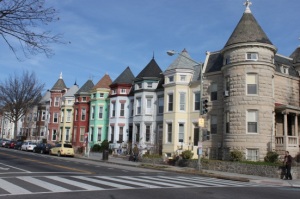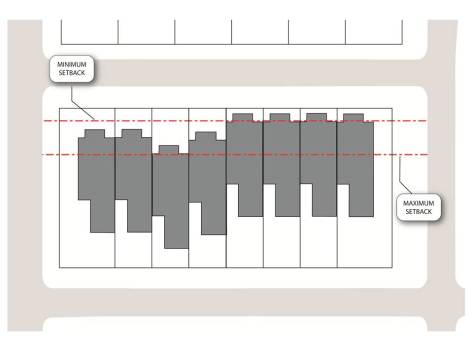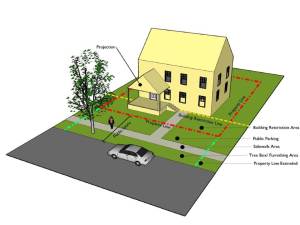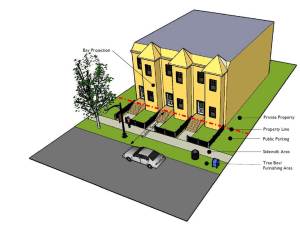Many cities have a front yard setback requirement, at least for low density residential areas. Washington DC does not. Why?
First – what is a front yard setback? Typically, it is a requirement that the house and other buildings be set back a certain distance from the front or street property line. DC has setback requirements, depending on the zone, from rear and side property lines, but not from the front. However, there typically is a landscaped area separating the house from the sidewalk, even in our denser rowhouse areas. This landscaped space between the sidewalk and the property line is confusingly called “parking” area (not car parking space), and is legally part of the city’s park and open space system.
So, how did this come to be?
DC’s streets are typically quite wide (yes, we know that there are some exceptions). We can thank Pierre L’Enfant for this. The 1791 L’Enfant Plan that established the street network within the boundaries of Florida Avenue to the north and the confluence of the rivers to the south had rights-of-way that ranged in width from 90 to 160 feet. The idyllic notion that the broad avenues would be picturesque carriage ways lined with double rows of trees was a nice idea. But in reality these wide streets presented a maintenance headache for the fledgling city and local government. To help the city deal with this, in 1870 Congress passed the Parking Act, which allowed the city to set aside parts of the street right-of-way as park land “to be adorned with shade-trees, walks, and enclosed with curbstones, not exceeding one half the width of any and all avenues and streets in the said city of Washington”.
The “parking” was extended to the residential areas beyond the L’Enfant Plan through the 1893 Highway Plan, developed by the Army Corps of Engineers at the request of the District Commissioners, the three-member body of presidential appointees who oversaw the day to day operations of District government. Between 1893 and 1898, the District Commissioners refined the Highway Plan in consultation with Frederick Olmsted’s firm – the landscape team responsible for New York City’s Central Park and the design of new residential communities like Roland Park in Baltimore and Riverside in Chicago.

The Highway Plan established a minimum 90’ street width; when properties were subdivided; new streets were established and were required to follow the plan. However, to reduce the amount of land property owners had to dedicate for streets, the city allowed building restriction lines on private property that established areas that were to remain open and that could count toward the 90’ street width – for example, a 60′ roadway with 15′ building restriction lines on both sides of the street (common in parts of DC) would add up to 90′. Not surprisingly, if you look at other cities and their regulations, you often find that the typical street width plus the required front yard setback results in a similar distance between the houses across the street from each other.
So, today, the character of our city’s residential neighborhoods is highly influenced by our street widths and the regulations governing public space. That green space between your front door and the sidewalk could be (depending on how your street was platted and the location of your home on your property) public space; private property with a building restriction line; your property because the house was built behind the property line; or, a combination of public space, building restriction area, and/or private property.
So, how does this relate to the proposed zoning regulations? Well, in the proposed new regulations, OP is not exactly proposing a front yard setback in the traditional sense. However, we are proposing a new kind of front setback, requiring that new development be set back from the front property line a distance consistent with other existing buildings on the block.
Why would we do such a thing? Currently, a dwelling can be constructed up to the front property line, even if all of the neighboring dwellings are set back further from the street. Or, conversely, it could be constructed way back from the front property line even if all of the other houses are close to or on the property line, leaving a “gap” in the street. We heard from many residents that this disrupts the character of a block, and we agree.
Our proposal is that new construction be required to be within the range of the existing block-face, between the maximum and minimum setback already found along that block, as in the diagram below.

The proposed regulations require that new development be set back from the front property line a distance consistent with other existing buildings on the block.
We actually already have this requirement in one part of the city, Wesley Heights, but we are recommending that it be applied in all low density residential areas to help preserve neighborhood character and maintain existing development patterns along a block.
(many thanks to Chris Shaheen, who manages the DC Office of Planning’s Public Space Program and his article on the Forest Hills Connection site from which we liberally borrowed)


Requiring a setback in order to preserve a park-like atmosphere is a good concept. Unfortunately, the greater number of the existing setbacks are poorly landscaped and, as many of the houses are narrow to begin with, the chopped-up effect of even good landscaping is still unsightly. Putting little fences between the lots looks pretty pitiful too. Therefore, unfortunately, I do not support this idea. If the requirement were for lots of at least 40 feet in width, that might work….
Ann Goodman
202-321-7250